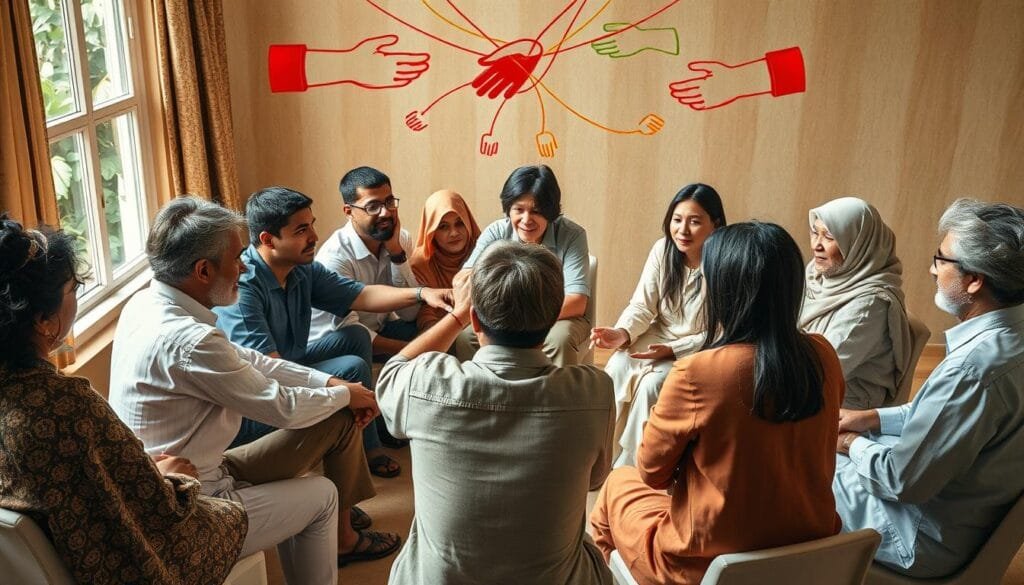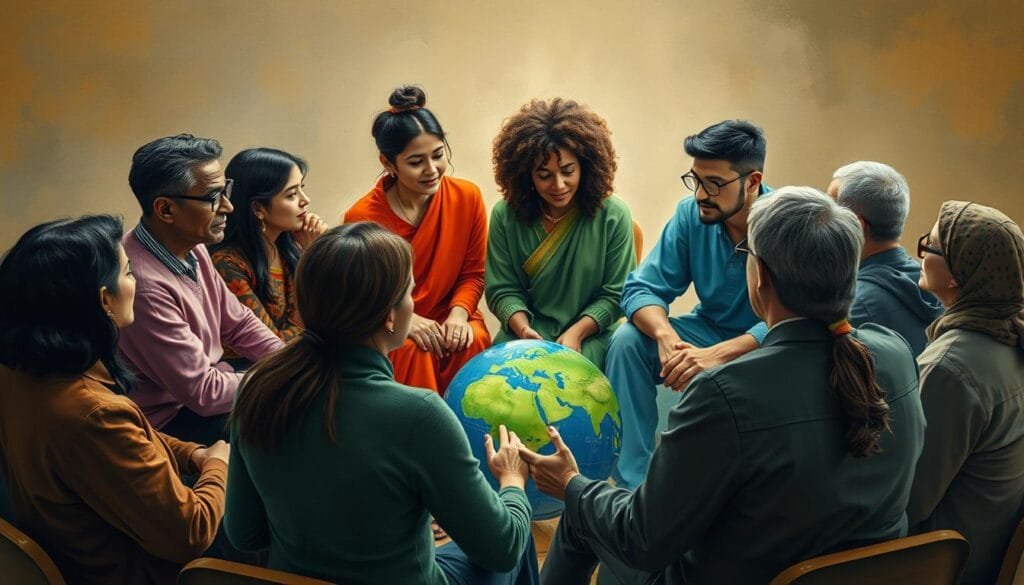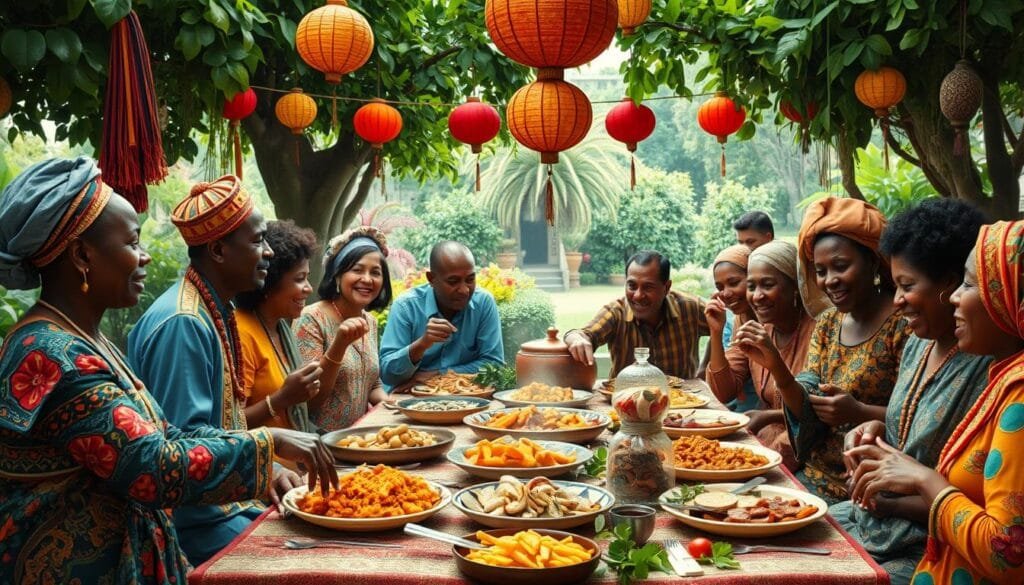Have you thought about what it takes to unite a group with different cultures? In today’s world, mixing various cultural traits is more important than ever. We aim to not just live together, but to really unite. We want to create a place where everyone feels part of something bigger.
The numbers show how our world is changing. For example, the Hispanic population in the U.S. might reach 25% by 2050. And by 2043, the U.S. will have more minorities than ever before. These changes show why being inclusive and sensitive to cultures is key. Plus, with thousands of hate crimes happening, we need to be better at understanding each other.
Key Takeaways:
- The growing global population includes diverse cultural backgrounds, necessitating cultural sensitivity and inclusivity.
- Statistical data suggest a significant increase in ethnic minority populations in the U.S. and Canada, highlighting the importance of multicultural integration.
- Hate crime incidents, often racially or ethnically motivated, point to the ongoing need for improved cultural harmony.
- Research on biases illustrates stress-related consequences for individuals with racial prejudices when interacting with diverse groups.
- Microaggressions can accumulate, affecting socio-emotional well-being and creating a hostile environment for everyone involved.
The Importance of Cultural Awareness
Cultural awareness means understanding and valuing diverse cultural backgrounds. It starts with knowing your own cultural influences and biases. By knowing how our culture shapes us, we can better connect with others.
Understanding Your Own Culture
To understand yourself, look into your culture’s beliefs, values, and norms. This helps us see how our culture impacts our views and behavior. Such self-knowledge helps us understand and respect different cultures.
Awareness of Other Cultures
Learning about and respecting other cultures is important. Organizations that value cultural awareness see many benefits. These include happier employees, less staff leaving, and better teamwork.
Research shows these organizations have 30% better employee retention and 50% more effective teams.
| Benefit | Statistic |
|---|---|
| Employee Engagement | 20% boost |
| Employee Retention | Improved by 30% |
| Team Collaboration | 50% increase |
| Financial Performance | 35% higher returns |
| Workplace Conflict Reduction | 25% reduction |
Cultural awareness improves how diverse teams talk to each other. Almost all cross-cultural misunderstandings are due to cultural differences, not language. By learning and training in diversity, workplaces can get along better. In today’s world, being aware of culture is key to success in life and work.
Building Trust and Relationships
Trust is very important in all successful relationships. This is especially true in a multicultural setting. We will look at ways to build trust across different cultures, highlight how setting goals together is key, and talk about keeping relationships strong through challenges.
Establishing Trust Among Diverse Groups
Building trust within diverse groups needs a good grasp of trust-building strategies. It’s important to create a space where everyone feels free to speak openly and is heard. A survey found that 78% of people in multicultural relationships say discussing cultural differences openly makes their relationship better. Groups that work together towards a common goal tend to be more effective and powerful. So, it is crucial to encourage transparency and have a shared goal.

Creating Shared Goals
Setting goals together is a great way to build trust. Having common goals brings people together and outlines the group’s path forward. Research shows that teams with lots of cultural diversity can be up to 35% more innovative than less diverse teams. This shows how important it is to include different viewpoints when setting goals. Making sure individual and group goals align helps keep multicultural relationships strong.
Maintaining Relationships Through Challenges
Keeping multicultural relationships strong means getting through tough times together. Honest talks and mutual respect are key in solving problems. It’s interesting to note that 55% of misunderstandings in cross-cultural interactions are due to different ways of communicating. This includes body language and humor. So, learning about different cultures and how to communicate effectively is very important for keeping relationships strong, even during hard times.
| Key Aspect | Impact on Relationships | Percentage |
|---|---|---|
| Open Communication | Improves Satisfaction | 78% |
| High Cultural Diversity | Increases Innovation | 35% |
| Effective Communication | Reduces Misunderstandings | 55% |
Effective Communication Strategies
Effective cross-cultural communication is vital in diverse teams. We’ll explore methods to overcome language barriers, understand nonverbal cues, and spark open dialogue. These steps build a more cohesive community.
Overcoming Language Barriers
Dealing with language differences is a big challenge. Cultures vary in how formal they are, like using “Herr” and “Frau” in Germany. Most people who don’t speak English as their first language find idioms and slang hard to get. This can cause misunderstandings.
Talking too fast increases misunderstandings in conversations with people from other cultures by 50%. Using simpler words and slowing down helps everyone understand better. Words with two syllables are easier to understand than those with three.
Active listening techniques can improve communication effectiveness by up to 40%.
This step is key to beating language barriers. It leads to better understanding and keeps information better. Plus, taking turns while talking can make conversations 30% more engaging. This makes talking smoother and more effective.
Understanding Nonverbal Communication

Nonverbal cues play a huge role in talking across cultures. Cultures differ in how they read these signals. For example, many Asian countries use nonverbal cues a lot to convey meaning. Meanwhile, places like the US and Germany depend more on verbal communication. Not getting these cues right can cause conflicts. It’s crucial to learn about nonverbal communication in a multicultural setting.
Encouraging Open Dialogue
Open dialogue is key in cross-cultural talks. Mixing open and closed questions helps avoid misunderstandings. Supporting communication boosts confidence in those not fluent in the main language. It can increase participation in discussions by 50%.
Creating a space for inclusive and open dialogue is important. Many folks in high-context cultures feel uncomfortable when humor is used in serious talks. Writing clearly also helps avoid confusion, like with the different ways the UK and USA show numbers.
Seeing different perspectives as strengths is good for everyone. Active discussions and taking turns speaking make conversations more inclusive. This builds trust and teamwork among diverse groups.
Using these strategies helps us communicate better across cultures. For more tips and info on connecting with people from different backgrounds, check out this resource.
Fostering Unity in a Group of People with Multiple Cultural Characteristics
Creating unity in a diverse group means more than recognizing differences. It’s about making shared experiences and inclusive practices a priority. This approach increases empathy and builds a base for mutual respect.
Shared Cultural Experiences
Shared cultural events help build unity. By celebrating and sharing their backgrounds, members gain a deeper understanding and respect for each other. For example, cultural fairs and international potlucks let members experience others’ traditions. These activities foster empathy and expand our viewpoints.

There’s a lot of proof that cultural experiences help communities bond. Studies show that embracing cultural diversity boosts problem-solving and creativity in groups. With diverse perspectives, we find better solutions that benefit everyone.
Inclusive Decision-Making Processes
Making sure everyone’s voice is heard makes people feel valued and part of the group. When everyone takes part in decisions, it builds trust and transparency.
Adapting to cultures in decision-making, such as through inclusive leadership, proves beneficial. A leadership reflecting diverse backgrounds can make more informed decisions. The technology used by Johnson & Johnson to reduce gender bias is a great example. It shows how diversity leads to fairness.
Data shows that inclusive environments have major benefits. For instance, schools with diversity programs see a 30% increase in student happiness and inclusivity. This highlights the power of involving everyone in making group decisions. It makes the group stronger and more unified.
The Role of Leadership in Promoting Cultural Harmony
Leaders in diverse areas must understand different cultural norms and sensitivities well. Their role is crucial in creating an inclusive, harmonious space. This space should honor and respect cultural differences.
Career growth consists of 10% skill, 30% image, and 60% visibility. This shows the need for leaders to not just be skilled, but also visibly promote cultural respect.
In cultures like Japan and Arab countries, non-verbal cues are very important. But in the USA and Germany, people prefer to be direct. Leaders must skillfully handle these communication styles. Scandinavian countries like democratic decisions, while Asian cultures are more hierarchical. Leaders play a key role in bridging these differences.
Harvard Business Review found diverse teams are 20% more innovative. Leadership that encourages everyone to contribute increases creativity. Organizations with inclusive decision-making are 30% more likely to keep top talent. This underlines the importance of leaders in creating a place where all voices matter.
Leaders with cultural intelligence, valued by 85% of executives, boost team unity and performance. Solving conflicts well leads to better team dynamics. 60% of leaders see the benefits of resolving disagreements.
Employees in culturally diverse places are 25% happier and more engaged at work. Companies focusing on cultural awareness reduce misunderstandings by 50%. This makes a strong case for cultural intelligence training.
Empathy is key, according to 40% of global leaders. It helps with teamwork and morale. Valuing different views results in 70% better decisions. This showcases the wider benefits of inclusive leadership.
In conclusion, leaders play a vital role in encouraging cultural respect and inclusion. They help bring diverse views together. This creates a thriving environment where each person is valued and respected.
Conclusion
As we think back on our journey, it’s clear that knowing about different cultures and talking well is key. We must truly understand various cultures in our connected world. Talking about how to bring different cultures together shows we need to know ourselves and others well. This helps build trust, talk better, and reach common goals.
Research tells us that when we respect different cultural backgrounds, people feel more accepted. This feeling of acceptance boosts success in many areas. It not only makes individuals do better but also makes our communities stronger. We see that everyone wins when we think about cultural diversity and include everyone in making decisions. This way, no one feels left out, and community projects work better.
When people from different cultures take part in community life, it gets richer. We need ongoing talks and active participation to solve issues around cultural identity and discrimination. Creating a welcoming and fair place lessens misunderstandings and prevents conflicts. In closing, our look into how to bring culturally diverse groups together shows that unity in diversity is crucial. It’s not just good for us; it’s necessary for moving forward together.
FAQ
How can we unite a group of people with multiple cultural characteristics?
To unite a diverse group, we should use strategies that integrate cultures well. We need to value every culture with respect and inclusion. This brings everyone together, fostering a united community.
Why is cultural self-awareness important?
Cultural self-awareness helps us know our own culture and its effects on us. By understanding ourselves, we can better understand others. This is key to promoting cultural harmony and improving communication.
How can we build trust among diverse cultural groups?
Building trust in diverse groups starts with creating common goals. These goals should serve everyone’s interests. It’s also important to communicate openly and respect each other, especially during difficult times.
What are effective strategies to overcome language barriers in a multicultural environment?
To overcome language barriers, use cross-cultural communication methods. This includes getting help from translators and learning basic phrases in several languages. Being patient, recognizing nonverbal signals, and promoting open talks are also crucial.
How can shared cultural experiences foster unity in a group with multiple cultures?
Shared cultural experiences help build empathy and understanding. By celebrating diverse cultures and discussing as a group, everyone’s perspective is honored. This approach makes the group stronger and more unified.
What role do leaders play in promoting cultural harmony within a group?
Leaders are vital in creating a culturally harmonious group. They must lead with fairness and include everyone. By being sensitive to cultural differences and showing everyone matters, leaders can make a strong, respectful community.
